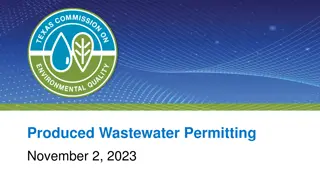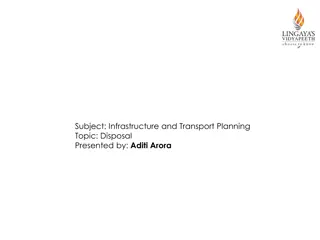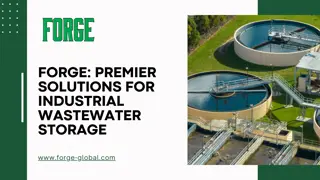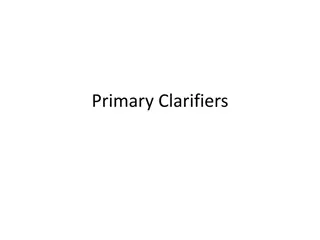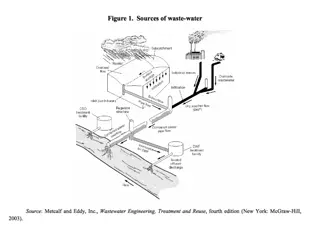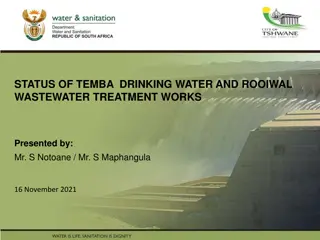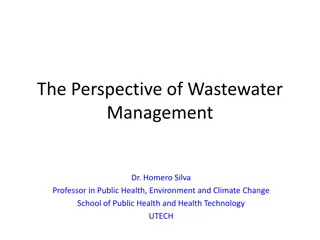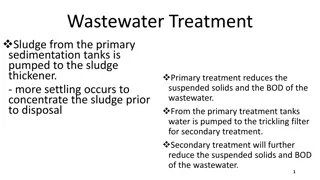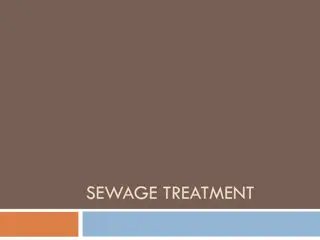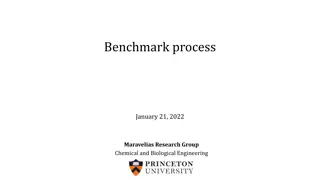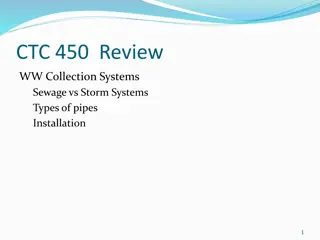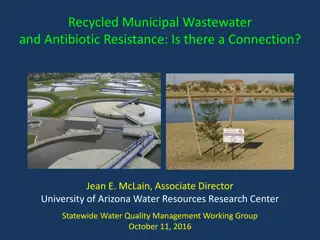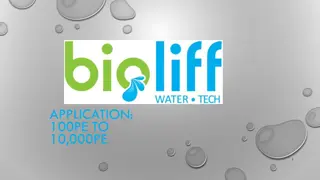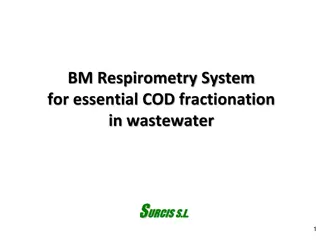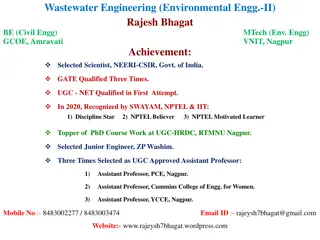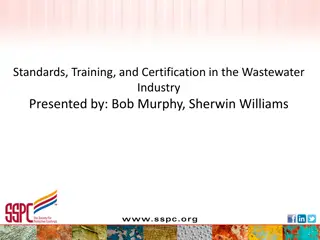Understanding Wastewater Engineering: Characteristics, Treatment, and Standards
Wastewater engineering involves studying the characteristics of wastewater, such as its strength and composition, to design effective treatment systems. This field covers topics like conventional sewage treatment plants, types of wastewater based on strength, and effluent standards for disposal. Understanding the importance of studying wastewater characteristics is crucial in ensuring pollutant removal to meet local authority standards. Key aspects include physical, chemical, and biological characteristics influenced by factors like water source, population, and industry practices.
- Wastewater Engineering
- Treatment Systems
- Water Pollution
- Effluent Standards
- Environmental Engineering
Download Presentation

Please find below an Image/Link to download the presentation.
The content on the website is provided AS IS for your information and personal use only. It may not be sold, licensed, or shared on other websites without obtaining consent from the author. Download presentation by click this link. If you encounter any issues during the download, it is possible that the publisher has removed the file from their server.
E N D
Presentation Transcript
Wastewater Engineering (Environmental Engg.-II) Rajesh Bhagat BE (Civil Engg) GCOE, Amravati Achievement: Selected Scientist, NEERI-CSIR, Govt. of India. MTech (Env. Engg) VNIT, Nagpur GATE Qualified Three Times. UGC - NET Qualified in First Attempt. In 2020, Recognized by SWAYAM, NPTEL & IIT: 1) Discipline Star 2) NPTEL Believer 3) NPTEL Motivated Learner Topper of PhD Course Work at UGC-HRDC, RTMNU Nagpur. Selected Junior Engineer, ZP Washim. Three Times Selected as UGC Approved Assistant Professor: 1) Assistant Professor, PCE, Nagpur. 2) Assistant Professor, Cummins College of Engg. for Women. 3) Assistant Professor, YCCE, Nagpur. Mobile No.:- 8483002277 / 8483003474 Email ID :- rajeysh7bhagat@gmail.com Website:- www.rajeysh7bhagat.wordpress.com
UNIT-III 1) Characteristics of wastewater. 2) Flow sheet of conventional sewage treatment plant. 3) Preliminary & Primary Treatment: Screens, Grit chambers, Primary settling tank. Design of bar screens, Grit chambers and Primary settling tanks. 2
Types of Wastewater According to Strength :- 1) Strong sewage: 2) Medium sewage: 3) Weak sewage: Strength of wastewater is expressed in terms of pollution load Parameter Strong Sewage Medium Sewage Weak Sewage COD 1000 mg/L 500 mg/L 250 mg/L BOD 400 mg/L 200 mg/L 110 mg/L TS 1200 mg/L 750 mg/L 350 mg/L SS 350 mg/L 200 mg/L 100 mg/L DS 300 mg/L 200 mg/L 70 mg/L
Effluent Standards for Disposal : PCB EPA WHO Parameter Water body Land Water body Land Land COD - - - - 250 BOD 30 100 20 100 100 TS - 250 400 1000 1000 SS 40 100 25 50 100 pH 6-9 6-9 6-9 6-9 6.5-8
Need of study of characteristics of wastewater ? Information about strength, composition & characteristics of wastewater is important in the design of treatment system & the amount of pollutants to be removed up to prescribed level set by the local authority.
Characteristics of Wastewater:- Wastewater contains organic & inorganic matters which may be suspended, colloidal & dissolved form. Characteristics depends on 1) Source of generation 2) Quality of water used 3) Culture of population 4) Conservation practice 5) Types of industries present 6) Treatment given by industries The characteristics can be classified as: 1) Physical 2) Chemical 3) Biological
Solids :- Very small amount of solids in relation to huge amount of liquid (99.9% water & 0.1% solids) TS Inorganic solids Organic solids SS SS CS CS DS DS Color :- 1) It can be detected by the naked eye 2) Yellowish, Grey, or light Brown color indicates fresh sewage. 3) The color of the septic & stale sewage is more or less black. 4) The color of the Industrial sewage depends on the chemical process used.
Odor :- 1) Fresh sewage has a slightly soapy or earthy or oily odor. 2) After 3 to 4 hour sewage start omitting offensive odors. Temperature :- 1) The temp. is slightly higher than the water 2) The avg. temp. of sewage is 370 cin India & 200 cin US. 3) Addition of Industrial sewage increases the temp. 4) Change in temp. affects the Bacteriological activities, treatment system, self purification of stream & aquatic life.
BOD :- The amount of oxygen required for microorganisms to carry out biochemical decomposition of biodegradable organic matter under aerobic conditions at specified temp. & duration. BOD5 at 200C= 68% of total BOD BOD5 at 370C= 70% of total BOD The consumed oxygen is related to the amount of decomposable organic matter. Aerobic decomposition of organic matter is done in two stages carbonaceous and nitrogenous stage. The first stage BOD is about 90% of the total BOD.
COD :- 1) The amount of oxygen required for chemical oxidation with help of strong chemical oxidant. 2) Determine in 3 to 5 hours. 3) Toxic metal can t interfere with COD test like BOD test. 4) Useful in determining the strength of industrial wastewater. 5) COD are generally higher than BOD values. 6) COD/BOD of typical sewage =1.25 to 2.5. 7) Higher ratio indicate the sewage is difficult to biodegrade.
pH: 1) The pH value indicates the ve log of hydrogen ion conc. present. 2) Indicator of the alkalinity of sewage. 3) A very high or low pH indicates of Industrial wastewater. 4) The activities of some microorganism are more in a specific pH value & similarly the chemical precipitation also depends on pH value. 5) Fresh & treated sewage is alkaline and partially treated sewage is acidic. Other parameters 1) Oil & grease 2) Nitrogen 3) Chloride 4) Heavy metals 5) Gases like oxygen, methane , hydrogen sulfide, etc.
Biological Characteristics: Related to the presence of microorganisms. The presence of pathogens indicates the degree of pollution. The presence of microorganisms affects the self purification of water 1. Bacteria: convert the complex organic matter into simpler form. 2. Algae: utilize the radiant energy, & absorb CO2 and release oxygen by photosynthesis. 3. Fungi: fully depended on organic matter for obtaining their energy. 4. Protozoa: bacteria eaters and destroy the pathogens.
Significance of BOD :- 1) Determining the strength of sewage. 2) Help in selection of required treatment methods. 3) To know the amount of treatment required for disposal. 4) Help in comparing various results, analysis & test. Determination of BOD :- 1) Sample is diluted in 1:100 ratio 2) First determine the DO in diluted sample before incubation. 3) Keep the diluted sample in incubator at temp. 20oc for 5 days. 4) Again determine the amount of DO after incubation. 5) Now difference between two is the amount of oxygen consumed by the sewage ie BOD5 at 20oc.
Limitation of BOD Test :- 1) Essential to have a high concentration of active bacteria present 2) Sample should not contain toxic waste. 3) The effects of nitrifying organisms should be reduced before BOD test. 4) Measure only the biodegradable organic matter. 5) Long time is required. 6) Utilization of soluble organic matter also affects the BOD determination.
Treatment of Wastewater :- Procedure of partial or complete removal of excessive impurities from wastewater for final disposal or suitable reuse. Need of Treatment :- 1) If the quantity of sewage is more then receiving water body will be polluted or land will be sewage sick because of limited self purification capacity of nature. 2) Discharge of large volume high strength sewage affects the environment adversely. 3) Therefore it is necessary to treat the sewage before disposal.
Objective of Treatment of Wastewater: 1) The main objective is to remove nuisance causing excessive impurities so that sewage can be safely discharged or reused. 2) Should not create unhealthy or unhygienic conditions. 3) Should not pollute the water body. 4) Should be useful for agriculture or any other purpose without any adverse effect. 5) All pathogenic bacteria should be killed.
Classification of Treatment Methods :- Treatment Methods Unit Operation Unit Process Biological Unit Process Chemical Unit Process Screening Grit chamber Detritus tank Floatation Sedimentation Flocculation Mixing Heat transfer & drying Suspended Growth process Ex. ASP Aerobic & anaerobic digester Neutralization Coagulation Precipitation Oxidation Disinfection Attached Growth Process Ex. Trickling filter RBC Unit operation is the method in which physical forces are predominant
Unit Operations :- The removal of contaminates is brought about by application of physical forces or physical forces predominate. 1) Screening 2) Mixing 3) Grit chamber 4) Detritus tank 5) Sedimentation tank 6) Floatation 7) Flocculation 8) SDB
Unit Processes :- The removal of contaminates is brought about by chemical or biological reaction Based on type of agent used they are again classified 1. Chemical Unit Process: reduction or removal is brought about by chemical reaction by adding chemicals. 2. Biological Unit Process: reduction or removal is brought about by microorganisms. A.Suspended Growth Process: The microorganisms are maintained in suspension by appropriate mixing technique. Ex. ASP, Lagoons, Oxidation ponds, Anaerobic digester, etc. B.Attached Growth Process: The microorganisms are attached to an inert packing materials Ex. Trickling Filter, RBC, etc.
Schematic Flow Diagram of a Typical Conventional Sewage Treatment Plant ASP Grit or Detritus tank Screening PST AT SST ASP Recirculation Raw Sewage Sludge Effluent for disposal Sludge Chlorine Disinfection Liquor Supernatant Sludge ASD ST Sludge ASD = Anaerobic Sludge Digester SDB = Sludge Drying Bed AT = Aeration Tank ASP = Activated Sludge Process SST = Secondary Sedimentation Tank PST = Primary Sedimentation Tank ST = Sludge Thickner Mannure or Dried Sludge for disposal SDB
Functions of Treatment Units:- Sump & Pump Well:- To collect wastewater in sump well & to pump the sewage to treatment units from pump wells. Approach Channel:- To dampen the wastewater flow before it is applied to subsequent treatment units so that wastewater flow remain as uniform as possible in the following units. Screen Chamber:- To remove large size & floating material in wastewater. To protect the following units getting damaged by abrasion & clogging. Grit Chamber:- To remove small & heavy inorganic solids ( size 0.2 mm & specific gravity 2.6 ) from the wastewater. Skimming Tank:- To collect & remove lighter particles, oil & grease from wastewater. (Oil & Grease Trap) Detritus Tank:- To remove heavy organic & inorganic natter from wastewater. Primary Settling Tank / Sedimentation Tank:- To remove fine suspended inorganic & settleable organic solids.
Functions of Treatment Units:- Biological Treatment Units:- To remove colloidal & soluble organic solids by aerobic & anaerobic process. Secondary Sedimentation Tank / Settling Tank:- To allow the microorganisms and other solids to settle & segregate sludge from wastewater. Sludge Thickener:- To thicken the biological or settled sludge by separation or removal of liquid or moisture content. Sludge Digester:- To treat the sludge by stabilizing before final disposal. To reduce the amounts of sludge to dewater or dispose. Sludge Drying Bed:- To dry & reduce the volume of the treated sludge by dewatering before final disposal.
Treatment System :- The type of combination used from the available unit operation and processes for treatment of a particular wastewater is known as the treatment system. Types of treatment system: 1. Preliminary Treatment 2. Primary Treatment 3. Secondary Treatment 4. Tertiary or Advanced or Final Treatment
Preliminary Treatment :- To remove floating material, large size particles & heavy inorganic contents of wastewater that cause operational problems in primary & secondary treatment. It is also known as pretreatment in conventional treatment system. The preliminary Treatment includes: 1. Screen Chamber: to remove large size floating materials. 2. Grit Chamber: to remove grit & sand. 3. Skimming tank: to remove oil & grease. 4. Detritus Tank: to remove heavy organic & inorganic matter
Primary Treatment :- To remove settleable suspended solids. The preliminary treatment unit as well as primary settling tank are included in the primary treatment system. Primary settling tank is also known as primary clarifier. Removal of organic matter in conventional treatment takes place in two steps. The settleable suspended organic matter is removed by PST while colloidal & soluble organic fraction is removed in secondary treatment system like SST.
Secondary Treatment :- To remove colloidal & soluble organic matter. Biological processes are used to remove remaining contents. Different treatment units are available: 1. ASP 2. Trickling filter 3. SST 4. RBC 5. Oxidation Pond or Waste Stabilization Pond 6. Oxidation Lagoons or Aerated lagoons 7. Oxidation ditches
Tertiary Treatment :- To remove the concentration of residual impurities after secondary treatment. Heavy Metals, Nutrient, TDS, etc Used for treatment for industrial wastewater. Very expensive. Different treatment units are available: 1. Ultra and Micro Filtration 2. Ion Exchange 3. Reverse Osmosis 4. Electro dialysis 5. Adsorption 6. Chemical Precipitation 7. Nitrification / Denitrification
Selection of Treatment System :- Mainly depends on the quality of raw wastewater and degree of treatment required. Other factors: 1. Availability of fund & land 2. Availability of equipment 3. Availability of skilled labor 4. Topography of land
Points to be Considered While Selecting Site of Treatment Plants :- 1) Availability of foundation strata should be good. 2) Slope of the ground. 3) Site should be at Lowest area of the city. 4) Availability of area for future. 5) Safe from floods. 6) Near from city. 7) Subsoil water level remain low even during mansoon. 8) Situated on the leeward side of wind.
Points to be Considered During Design of Treatment System/Plant :- 1) Design period should be taken between 15-20 years 2) Design should be done on the avg. domestic flow plus max industrial flow 3) More number of smaller units 4) Self cleansing velocity 5) Economical 6) Easy in maintenance and flexible in operation 7) By-pass should be provided
Effects of Impurities :- 1) Suspended solids can cause sludge deposits and anaerobic conditions in the environment 2) Biodegradable organics can cause anaerobic conditions in the environment Pathogens transmit disease 3) 4) Nutrients can cause eutruphication 5) Heavy metals toxicity to biota and humans 6) Dissolved solids interfere with reuse
BOD exerted or removed is given by, Yt = Lo ( 1 - e -k t ) Rate of BOD removal with time is directly proportional to BOD remained at any time. ( dL / dt ) L Lt = BOD remained at any time. k = BOD rate constant to the base e, d -1 K = BOD rate constant to the base 10, d -1 K = 0.1 at 20 0c Yt = BOD exerted or removed after any time. Lo = Ultimate BOD. Mg/L t = Time in days ( dL / dt ) = - k L dL / L = -k dt Integrate it, Lo Lt dL / L = - k o t dt ( Logn L )LtLo = - k (t + c)to Logn Lt Logn Lo = -k t
BOD exerted or removed is given by, Yt = Lo ( 1 - e k t ) Logn Lt Logn Lo = -k t Logn (Lt / Lo) = - k t Lt / Lo = e - k t Lt = Lo e - k t Now, Ultimate BOD = BOD remained + BOD exerted Lo = Lt + Yt Yt = Lo Lt Put Lt = Lo e - k t Yt = Lo - Lo e - k t Yt = Lo (1 - e - k t) k = 0.23 / day Yt = Lo (1 - 10 - K t) K = 0.1 / day Temp. correction factor, KT = K20 (T-20) Temp coeff. Factor, =1.047 when temp. is greater than or equal to 20 0c Temp coeff. Factor, =1.135 when temp. is less than 20 0c
If BOD5 of a sample measured at 200C is 250 mg/L. Determine the 3 days BOD at 270C. Assume reaction rate constant k (base e ) k = 0.23 /day at 200C.
3 days BOD of a wastewater sample at 370C is 300 mg/l. Calculate its 10 days BOD at 200C and 5 days BOD at 300C. Assume BOD rate constant at 200C as 0.23 per day.
Screening:- 1) It is the process of trapping and removing larger & coarser floating materials like pieces, cloth, plastic, wood, etc. 2) Done by allowing a wastewater to flow through the screens. 3) Screens may consists of parallel bars, rods, wiremeshes, etc. 4) First unit operation encountered in wastewater treatment plants. 5) Frequently required to be cleaned, otherwise head loss will increase across the screen by clogging the screen. Coarse screen- Opening Size > 20 mm Medium screen- Opening size 10 to 20 mm Fine screen Opening < 10 mm Micro screen Opening < 0.5 m
Grit Chamber:- 1) Grit or inorganic material is removed by grit chamber. 2) Velocity of flow is reduced to such an extent that heavier inorganic materials settle down at bottom of grit chamber. 3) It has a lesser detention time of 1 minute and flow velocity 0.2 to 0.3 m/s 4) Flow velocity should neither far low to cause settling of lighter organic matter nor should so high not to cause the settlement of the grit. 5) Provided to protect moving mechanical equipment from abrasion & wear. 6) There are two types of grit chamber :- Horizontal flow & aerated grit chamber.
Que. 8 Design a grit chamber of rectangular c/s if the maximum wastewater flow rate is 8000 m3/day to remove particles upto 0.2 mm diameter with specific gravity of 2.65. Max. flow rate = 8000 m3/day = 0.0926 m3/s Assume flow velocity. vH = 0.25 m/s Assume Detention Time, t = 60 seconds Length of Girt chamber, L = vH x t = 0.25 x 60 = 15 m c/s area of chamber, A = (Q / vH ) = 0.0926 / 0.25 = 0.37 m2 Settling velocity, vs = d (3T +70) T = Temp. 20 0C & d = 2 x 10 4 m Settling velocity, vs = d (3T +70) = 2 x 10 -4 (3 x 20 +70) = 0.026 m/s Depth of chamber, = vs x t = 0.026 x 60 = 1.56 m Width of chamber, B = (c/s Area) / Depth = 0.37 / 1.56 = 0.24 m Assume F.B. = 0.2m & Sludge depth = 0.2m Overall depth = 1.56 + 0.2 + 0.2 = 1.96 m say = 2m Hence Provide a grit chamber of size 15m x 0.24m x 2m



